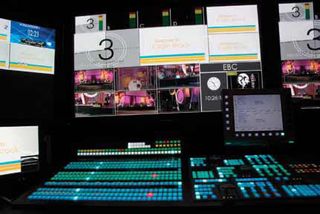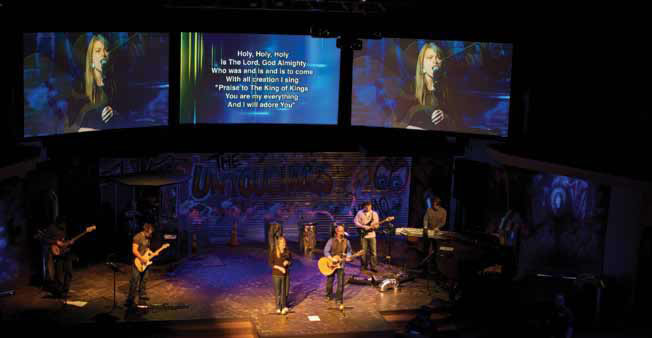Houses Of Worship Take Advantage Of New Video Switching Technologies
by Carolyn Heinze
Not that long ago, high-definition video was something that only the largest churches could afford. As HD caught on, however, price points decreased, rendering it more affordable for smaller congregations.
Three FSR Eagle 200/HD switchers were installed by Summit Integrated Systems at the Colonial Baptist Church of Wichita Falls, TX. An Eagle is assigned to each of three 8-foot by 14-foot screens arranged in a nearly continuous curve, enabling three separate images or one stretched moving background.
This price decrease has driven manufacturers to develop HD systems equipped with more features that are tailored to specific applications, such as those employed in the house of worship environment. “As the displays and the projectors have come down in price, the rest of the industry has adapted to that in trying to come out with more high definition equipment and features,” observed Seth Teates, Mid-Atlantic sales manager at switcher/scaler manufacturer Analog Way. The overall video quality that churches have access to today has significantly increased, he added.
One common application that churches make great use of is image magnification (IMAG), which enables congregation members seated further away from the pulpit to enjoy a close-up view of the pastor and the worship team. This means that churches demand good image quality for a number of reasons, Teates noted. “Image quality is imperative, because the pastor wants to look good and it’s the image of the church that’s being displayed up there,” he said.
Latency, or lack thereof, is also high priority, in order to avoid what Teates labeled the ‘kung fu’ effect, referring to the old movies where the actors’ lips were not synchronized with the audio. “If you have a processor, you might have great image quality but if it’s delayed by three, four, or five frames, reality does not match what’s happening up there on the screens,” he said. Good products, therefore, are designed to provide high resolution and low latency simultaneously.

A Ross Video Vision 3 QMD Multi-Definition Production Switcher and SoftMetal 3000 Series Video Server are used at Eagle Brook Church’s main campus in Lino Lakes, MN.
Jeff Moore, executive vice president of sales and marketing at production equipment manufacturer Ross Video, noted that many churches have established satellite campuses, which offer portions of the service that takes place at the ‘main’ church, and integrate them into services that are tailored to remote congregations. “We are supplying delay equipment to delay these services by 10 or 15 minutes so that the remote location has the ability to get ready for what’s coming up, because things don’t always go exactly according to schedule,” he explained. This gives the production team at the remote site time to react and adjust their production accordingly.
One of the challenges that the industry has been forced to deal with is the non-broadcast equipment that has made its way into video production, noted Erik Iversen, product applications manager in the image processing department of the video technology developer Barco. “For example, there are Blu-ray players and laptops that are taking the place of big, expensive title generators,” he said. This has produced a wide variety of signals to process—a challenge that Barco has responded to with its FSN video switcher. “That is one of the biggest questions that we’re answering right now: How to deal with not only analog and digital signals as well as high definition and standard definition, and then converting them all, and trying to create one picture out of it.”
While HD is becoming more accessible to a greater number of organizations, it has yet to be adopted by everyone. “There are still many congregations out there today that can’t afford high definition,” Teates said. “There will continue to be a reduction in the price of technology, and we are going to have better image quality, lower latency and more features, and the price will continue to trickle down to open this up to smaller congregations with fewer financial resources.”
As smaller facilities start to adopt higher-end technology at a lower price, the focus is on simplifying it all. “It’s going the way of the corporate presentations, where we have a lot of different things coming in that we need to deal with quickly and easily,” Iversen said. People are starting to be less interested in glitzy effects, and more on simple, solid presentations. “They don’t need all of the fancy transitions—they need to deliver a message. Simplifying the engineering behind that is a big trend that we’re going to see, moving forward.”
Tailor Made
Because most churches have a board of directors, or board of elders, it’s necessary for systems contractors to navigate through the powers that be in order to reach the right person—the one with the power to sign off on an integration project.
While this applies to almost every church, not all churches are striving for the same results when it comes to the actual technology that they purchase. Seth Teates of Analog Way noted that in order to achieve the best results, systems contractors must spend the necessary time learning about the church and its goals. “Some churches cater more to, for example, deaf people, and they may need more IMAG and closed captioning," he said. "For another church, that may not be as important.”
Barco’s Erik Iversen encourages systems contractors to work closely with manufacturers, especially when they are in the initial stages of a project. “They should involve the manufacturer early in the game before the specifications have been made,” he said. “We know our products inside and out and can provide the right solution, and perhaps suggest some other ways of enhancing the church’s experience. If we get involved in the action sooner, we can provide a much better solution.”
New Heights

The video production room at The Heights Baptist Church is centered around the FOR-A HVS-300HS HD/SD video switcher.
As part of its recent upgrade to HD, The Heights Baptist Church, located in Richardson, TX, installed a FOR-A HVS-300HS HD/ SD video switcher. Previously, video production at The Heights was standard definition. Now, from the camera through switching and processing, the worship facility features an all-HD workflow.
About 5,000 parishioners attend two services each Sunday, plus special concerts throughout the week, at The Heights. For presentation within the church, the HVS-300HS switches between four Canon XL H1S HD camcorders and one Sony HD robotic camera for image magnification (IMAG). There is a different crew of volunteers for each service, consisting of five camera operators, CG operator, audio operator, technical director, and director.
Digital Resources, an integrator based in Southlake, TX, provided the installation, and an engineer from FOR-A came out to The Heights to train the production staff. “With volunteer crews, the key feature is how intuitive the HVS-300HS is for a non-professional to adapt to,” said Bobby Dennis, technical director at The Heights. “Yet it’s not limited— we can do anything. The sophistication of the FOR-A has been wonderful visually.”
Carolyn Heinze is a freelance writer/editor.










